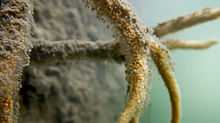Gemmule
This article is about the internal buds of freshwater sponges. For the proposed mechanism of heredity, see Gemmule (pangenesis).

Gemmules
Gemmules (Spongilla lacustris)
Gemmules are internal buds found in sponges and are involved in asexual reproduction. It is an asexually reproduced mass of cells, that is capable of developing into a new organism i.e., an adult sponge.
Role in asexual reproduction
The asexual reproduction in sponges is by budding. The buds may be external or internal. The internal buds are called gemmules. Both types of buds develop into new sponges.
Characteristics
They are resistant to desiccation (drying out), freezing, and anoxia (lack of oxygen) and can lie around for long periods of time. Gemmules are similar to a bacterium's endospore and are made up of amoebocytes surrounded by a layer of spicules and can survive conditions that would kill adult sponges. When the environment becomes less hostile, the gemmule resumes growing.
References
- Feldkamp, Susan (2002). Modern Biology. United States: Holt, Rinehart, and Winston. p. 695. Accessed on May 23, 2006.